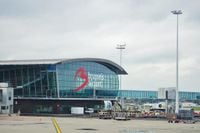Belgium’s busiest airports were thrown into chaos on the evening of November 4, 2025, as a series of suspected drone sightings forced the suspension of flights, stranding hundreds of passengers and triggering a national security response. The disruptions, which began just after 8:00 p.m. local time, rippled across the country’s aviation network and raised fears of a coordinated campaign targeting both civilian and military infrastructure.
According to AP, the first drone was spotted near Brussels Airport—Belgium’s main international gateway—prompting immediate suspension of all flight operations. Skeyes, the national air traffic control authority, halted flights not once, but twice that evening: first around 20:00 and again at 22:00, as further drone sightings were reported. Ariane Goossens, spokesperson for Brussels Airport, told the press that normal operations were expected to resume the following day, but warned that delays and cancellations could continue into Wednesday morning.
By the time the dust settled, the numbers told a story of widespread disruption. FlightAware, a leading flight tracking service, counted 59 cancellations and 43 delays at Brussels Airport alone, while departing flights saw 34 cancellations and 36 delays, and arrivals suffered 27 cancellations and 14 delays, according to Simple Flying. Around 400 to 500 travelers were forced to spend the night at the airport. Staff scrambled to set up camp beds and distribute food and water, striving to keep stranded passengers as comfortable as possible. "The safety of our passengers and staff remains our top priority," the airport operator said in a statement quoted by AP.
The chaos was not limited to Brussels. Liege Airport—one of Europe’s largest cargo hubs—also suspended operations after a drone sighting, as reported by Belgium’s public broadcaster RTBF and BBC. The disruption quickly spread: Charleroi Airport, Belgium’s second busiest, was forced to halt air traffic as a precaution, and flights were diverted to airports in Amsterdam, Maastricht, Ostend, and Eindhoven. In total, Charleroi handled six diverted flights from Brussels, including those operated by Brussels Airlines, Ryanair, and Scandinavian Airlines (SAS).
But the scope of the drone activity extended beyond civilian airports. On the same evening, six drones were reported near Kleine Brogel Air Base—a highly sensitive site housing Belgian F-16 fighters and, crucially, U.S. nuclear weapons under NATO sharing agreements. Local residents also reported drone sightings over Florennes Air Base, where Belgium had recently taken delivery of its first F-35A fighter jets. According to Simple Flying, this marked the fourth consecutive night of drone incursions at Kleine Brogel, following similar incidents over the preceding weekend.
Belgian Defense Minister Theo Francken did not mince words about the seriousness of the situation. Speaking to local media, he described the drone flights as “a clear command targeting [the] Kleine Brogel” airbase, adding, “They come to spy, to see where the F-16s are, where the munitions are, and other highly strategic items.” Francken further explained that the operation appeared to be executed in two phases: first, smaller drones tested the radio frequencies used by Belgian security forces to jam unauthorized flights; then, larger drones operated on different frequencies to evade those jammers. “This is not the work of amateurs,” he insisted, as reported by AP. “They are trying to sow panic in Belgium. This is destabilisation.”
Interior Minister Bernard Quintin echoed the gravity of the threat. “The repetition of incidents linked to drones directly affects the security of our country,” he posted on social media. “We must take action in a calm, serious and coordinated manner.” In an interview with Radio 1’s De Ochtend, Quintin was careful not to jump to conclusions about the culprit: “It could be either Russia or a hobbyist. I remain cautious,” he said, emphasizing that the ministry was investigating all possible leads.
The national response was swift. Prime Minister Bart De Wever convened an urgent meeting of Belgium’s National Security Council for the morning of November 6, 2025, bringing together the defense, interior, justice, and foreign ministers to assess the threat and coordinate next steps. Military intelligence services also launched investigations into the drone sightings, particularly those near sensitive military sites.
The timing of these incidents has not gone unnoticed in the broader European context. Since September 2025, Europe has been rattled by a spate of mysterious drone sightings near civilian airports and military installations in countries including Denmark, Germany, Norway, Poland, Estonia, Lithuania, and Latvia. Denmark’s intelligence service has publicly linked some of these flights to Russia, describing them as a form of hybrid warfare designed to “put pressure on [Europe] without crossing the line into armed conflict in a traditional sense,” according to Reuters. Moscow, for its part, has denied any involvement, but suspicions remain high as the war in Ukraine drags into its fourth year and tensions with Russia remain elevated.
Belgium’s strategic importance only heightens the stakes. The country hosts the headquarters of both NATO and the European Union, as well as Europe’s largest financial clearinghouse, which holds tens of billions of euros in frozen Russian assets. Many EU nations have pushed to use these assets as collateral for loans to Ukraine—a move Belgium has so far resisted, with Prime Minister De Wever warning EU leaders that Russia could retaliate if the funds are confiscated.
For many Belgians, the drone incidents have brought the realities of modern security threats uncomfortably close to home. Pictures from inside Brussels Airport showed weary passengers huddled on camp beds, waiting for news. For others, the specter of invisible, hard-to-trace technology disrupting daily life and targeting critical infrastructure is a wake-up call about the vulnerabilities of an increasingly connected world.
As of Wednesday, November 5, 2025, Brussels Airport and other affected hubs had resumed normal operations. Yet, as Ariane Goossens, the airport’s spokesperson, cautioned, “The situation will return to normal during the day,” but the underlying concerns remain. Investigations are ongoing, and authorities are on high alert for further incidents. Whether the recent wave of drone activity is the work of a state actor or a sophisticated criminal group—or, as some still hope, merely an audacious hobbyist—remains to be seen. What’s clear is that Belgium, like much of Europe, is grappling with a new frontier in security, where the sky above is no longer a guarantee of peace and quiet.


